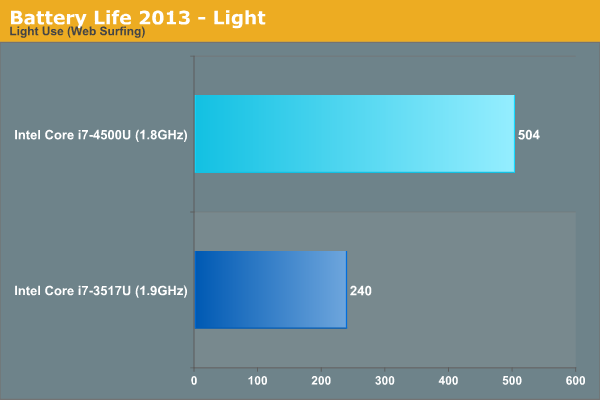The Haswell Ultrabook Review: Core i7-4500U Tested
by Anand Lal Shimpi on June 9, 2013 9:00 AM ESTBattery Life
I didn’t get my hands on the Haswell S7 until a few hours after I landed in Taipei. My hotel’s in-room internet was throttled to around 2.5Mbps, which wasn’t enough bandwidth to reliably run our web browsing battery life tests. Luckily, I had my review copy of PCMark 8 on hand with its new built in battery life tests. I asked Jarred to run comparison data on the Ivy Bridge S7.
We had time to perform multiple runs on two of the tests: Home and Creative.
From the PCMark 8 Technical Guide:
The PCMark 8 Home benchmark test includes a set of workloads that reflect common tasks and activities performed by a typical person at home. These workloads generally have low computational requirements making the PCMark 8 Home benchmark suitable for testing the performance of low-cost tablets, notebooks and desktops.
The PCMark 8 Home benchmark test contains the following workloads: Web Browsing, Writing, Casual Gaming, Photo Editing and Video Chat.
The PCMark 8 Creative benchmark test includes a set of workloads that reflect tasks and activities typical of more advanced home computer users. With more demanding requirements than the Home benchmark, the PCMark 8 Creative test is suitable for testing the performance of mid-range computer systems. Your system must have a GPU with full DirectX 11 support in order to run all the workloads in the PCMark 8 Creative benchmark.
The PCMark 8 Creative benchmark test contains the following workloads: Web Browsing, Photo Editing, Batch Photo Editing, Video Editing, Media to Go, Mainstream Gaming and Group Video Chat.
As always, I calibrated both displays to the same brightness (200 nits). In the case of the Haswell based S7, I disabled all additional display power saving options in the Intel driver. Keeping in mind the new S7 has a 33% larger battery, I’m presenting both absolute battery life numbers as well as minutes per Wh for normalized comparisons.
The PCMark 8 Home battery life test is the lighter of the two, and thus has the best chance of showing peak improvement on Haswell. The results are very good:
| PCMark 8 Battery Life | ||||
| PCMark 8 Home | PCMark 8 Home (Normalized) | PCMark 8 Creative | PCMark 8 Creative (Normalized) | |
| Acer Aspire S7-391 (Core i7-3517U) | 2.83 hours | 4.857 mins/Wh | 3.35 hours | 5.743 mins/Wh |
| Acer Aspire S7-392 (Core i7-4500U) | 5.2 hours | 6.783 mins/Wh | 5.12 hours | 6.674 mins/Wh |
| Haswell Advantage | 39.6% | 16.2% | ||
In both benchmarks, Haswell ULT delivers 11 - 14% better performance and substantially longer battery life. Normalized for battery capacity, Haswell ULT offers 16% better battery life in the Creative test and almost 40% better battery life in the Home test. Note that the performance advantage pretty much disappears once we move to the Balanced power profile with the laptop connected to the wall.
| PCMark 8 Performance | ||||
| PCMark 8 Home (Power Saver) | PCMark 8 Home (Balanced) | PCMark 8 Creative (Power Saver) | PCMark 8 Creative (Balanced) | |
| Acer Aspire S7-391 (Core i7-3517U) | 1595 | 2694 | 1391 | 2508 |
| Acer Aspire S7-392 (Core i7-4500U) | 1777 | 2832 | 1583 | 2553 |
| Haswell Advantage | 11.4% | 5.1% | 13.8% | 1.8% |
Update: I made it back to the US, equipped with decent internet speeds, I was able to run our light 2013 web browsing battery life test. The increase in battery life is tremendous:

The new S7 delivers over 2x the battery life of the old model. Normalizing for battery capacity, the improvement due to Haswell is 57.5%. These results track perfectly with what we saw in PCMark 8. Workloads with greater idle time will show the biggest improvement in battery life thanks to Haswell ULT.










87 Comments
View All Comments
JDG1980 - Sunday, June 9, 2013 - link
Do Haswell notebook chips have the same crazy high temperatures on full load that the Haswell desktop chips do?dealcorn - Sunday, June 9, 2013 - link
I am not comfortable with your suggestion that DEVSLP's 2 mw benefit shows exclusively/primarily when the system is asleep. I sense a big benefit at low loads because the SSD's can slip in and out of DEVSLP really fact. Let's have some testing, at your leisure. Will a SSD be in DEVSLP state 50% of the time while watching non HD video? I suspect power requirements during DEVSLP is the new idle power measurement for typical home use and SSD reviews should be revised accordingly.Everything else: Bravo!
Sivar - Sunday, June 9, 2013 - link
Typo:"Haswell less than a month after the arrival of a new CEO"
Just trying to help out. :)
kallogan - Sunday, June 9, 2013 - link
What a tech revolution, a bigger battery gives a bigger battery life.FwFred - Sunday, June 9, 2013 - link
Reading is FUNdamental: "Using Acer’s Aspire S7 as a comparison platform and NORMALIZING FOR BATTERY CAPACITY DIFFERENCES I measured anywhere from a 15% to a 60% increase in battery life thanks to the move to Haswell."Emphasis mine.
kallogan - Sunday, June 9, 2013 - link
Scam. A well optimised ivy lap would do the same.Egg - Sunday, June 9, 2013 - link
Proof?Homeles - Monday, June 10, 2013 - link
I see that reading comprehension is not your strong point.kallogan - Monday, June 10, 2013 - link
I just need more than one Haswell based laptop review to draw any conslusions.seapeople - Tuesday, June 11, 2013 - link
Me too. I think Anand should have held any Haswell reviews until we've had a good five years for industry to comprehensively adopt the architecture and fundamentally evaluate the aggregate system stability on an enterprise-wide scale. Then he could submit all the reviews he had saved up.